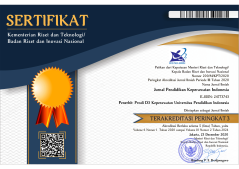Career Choices among Nursing Students: Differences between Freshmen and Interns
Abstract
ABSTRACT
Career selection is one of the most important decisions that an individual makes in his life and is a core task of the late stages of adolescent development in the process of developing self-identity. This study aimed to describe the career choices of nursing students and analyze the differences between freshmen and interns. This cross-sectional study involved 110 and 66 freshmen and interns respectively in two private nursing colleges with “B” accreditation predicate (n=176). Questionnaire of Survey on Career Choice was used in data collection. Descriptive statistic test was used in data analysis. Results showed that most freshmen chose two career choice alternatives (38.18%), but most interns were determined to choose only one alternative (42.42%). There were two most popular career choices among nursing students, such as: nurse practitioner (45.45% totally) and continuing education to be a Master/Specialist of Nursing (33.52% totally). The career intention to be a nurse practitioner in most respondents was referred to civil servant, both in clinical or community work places (59.66% totally). The most popular nursing fields were pediatric nursing in freshmen and psychiatric nursing in interns (34.55% and 25.76% respectively). Strengthening the attitude of love for nursing profession needs to be fostered early in the beginning of college life, so that career choice as a nurse practitioner after finishing the internship program can be maintained.
ABSTRAK
Pemilihan karir adalah salah satu keputusan terpenting yang dibuat individu dalam hidupnya dan merupakan tugas inti dari tahap perkembangan remaja akhir dalam proses pembangunan identitas diri. Penelitian ini bertujuan mendeskripsikan pilihan karir mahasiswa keperawatan dan menganalisis perbedaannya di antara mahasiswa baru dan program Profesi Ners. Penelitian cross-sectional ini melibatkan 110 maba dan 66 mahasiswa profesi yang berasal dari dua institusi keperawatan terakreditasi B (n=176). Kuesioner Survey on Career Choice digunakan dalam pengumpulan data. Uji statistika deskriptif digunakan untuk menganalisis data. Hasil menunjukkan mayoritas maba memilih dua alternatif pilihan karir (38.18%), sedangkan mahasiswa profesi Ners mantap memilih satu pilihan saja (42.42%). Terdapat dua jenis pilihan karir yang populer pada mahasiswa keperawatan, yaitu sebagai perawat praktisi (total 45.45%) dan studi lanjut untuk menjadi Magister/Spesialis Keperawatan (total 33.52%). Intensi karir sebagai perawat praktisi pada mayoritas responden mengarah pada menjadi Pegawai Negeri Sipil (PNS), baik di tatanan klinik maupun komunitas (total 59.66%). Bidang Keperawatan Anak paling populer di kalangan maba (34.55%), sedangkan bidang Keperawatan Jiwa paling populer di kalangan mahasiswa Profesi Ners (25.76%). Penguatan sikap kecintaan terhadap profesi perawat perlu dipupuk sejak dini di awal masa kuliah agar pilihan karir sebagai perawat praktisi pasca lulus dari program Profesi Ners dapat dipertahankan.
Keywords
Full Text:
PDFReferences
Aguiar, M. I. F., Lima, H. P., Braga, V. A. B., Aquino, P. S., Pinheiro, A. K. B., & Ximenes, L. B. (2012). Nurse competencies for health promotion in the mental health context. Acta Paulista de Enfermagem, 25(2), DOI: http://dx.doi.org/10.1590/S0103-21002012000900025.
Bennett, J. F., Davidson, M. J., & Galeand, A. W. (1999). Women in construction: a comparative investigation into the expectations and experiences of female and male construction undergraduates and employees. Women in Management Review, 14(7), 273-291.
Bolan, C., & Grainger, P. (2009). Students in the BN program – Do their perceptions change? Nurse Education Today, 29(7), 775-779.
Costa, A. C. P. J., Carvalho, Q. G. S., Lima, S. C. D., Ximenes, L. B., Pinheiro, A. K. B., Castro, R. C. M., Aquino, P. S., & Vieira, N. F. C. (2016). Nursing competencies for child health promotion. Journal of Nursing Education and Practice, 6(4), 130-135.
Currie, J. (2006). Clinical competence in caring for paediatric patients. Emerg Nurse, 14(2), 12-15.
Diomidous, M., Mpizopoulou, Z., Kalokairinou, A., Mprokalaki, I., Zikos, D., & Katostaras, T. (2012). Descriptive Study of Nursing Students‘ Motives to Choose Nursing as a Career. Retrieved from: journal-ene.gr/wp-content/uploads/2013/07/descriptive_study_nursing_students.pdf
Ettigi, S. (2017). The role of family expectations and internalized model minority on career choices of south Asian American college students. Dissertation. ProQuest Dissertations Publishing, 10619003.
Feinstein-Messinger, G. (2007). The nexus among career decision self-efficacy, parental relationship factors, and career indecision among college students from different ethnic and racial groups. Dissertation. ProQuest Dissertations Publishing, 3245030.
Flinkman, M., Isopahkala-Bouret, U., & Salantera, S. (2013). Young registered nurses' intention to leave the profession and professional turnover in early career: a qualitative case study. International Scholarly Research Notices, vol. 2013, 916061, DOI: http://dx.doi.org/10.1155/2013/916061.
Garcia, P. R. J. M., Restubog, S. L. D., Bordia, P., Bordia, S., & Roxas, R. E. O. (2015). Career optimism: the roles of contextual support and career decision-making self-efficacy, Journal of Vocational Behavior, 88, 10-18.
Gati, I., Krausz, M., & Osipow, S. H. (1996). A taxonomy of difficulties in career decision making. Journal of Counseling Psychology, 43(4), 510-526.
Ghanbari, A., Hasandoost, F., Lyili, E. K., Khomeiran, R. T., & Momeni, M. (2017). Assessing emergency nurses' clinical competency: an exploratory factor analysis study. Iran J Nurs Midwivery Res., 22(4), 280-286.
Gillespie, B. M., Chaboyer, W., Wallis, M., Chang, H-Y. A., & Werder, H. (2009). Operating theatre nurses’ perceptions of competence: a focus group study. Journal of Advanced Nursing, 65(5), 1019-1028.
Grainger, P., & Bolan, C. (2006). Perceptions of nursing as a career choice of students in the Baccalaureate nursing program. Nurse Education Today, 26(1), 38-44.
Haase, H. (2011). Career Choice Motivations of University Students. International Journal of Business Administration, 2(1). Retrieved from: https://doi.org/10.5430/ijba.v2n1p2
Heggli, G., Haukanes, H., & Tjomsland, M. (2013). Fearing the future? Young people envisioning their working lives in the Czech Republic, Norway and Tunisia. Journal of Youth Studies, 16(7), 916-931.
Kloster, T., Hoie, M., & Skar, R. (2007). Nursing students’ career preferences: a Norwegian study. JAN, 59(2), 155-162.
Kunnen, E. S. (2013). The Effects of Career Choice Guidance on Identity Development. Retrieved from: http://dx.doi.org/10.1155/2013/901718
Laveck, L. M. (2018). Career decision-making difficulties among student veterans. ProQuest Dissertations Publishing, 11005236.
Leung, A., Hou, Z. J., Gati, I., & Li, X. (2011). Effects of parental expectations and cultural-values orientation on career decision-making difficulties of Chinese University students. Journal of Vocational Behavior, 78(1), 11-20.
Lockridge, E. J. K. (2000). Career aspirations and expectations of selected Texas high school students as they relate to demographic characteristics and occupational projections. ProQuest Dissertations Publishing, 9980180.
Lounsbury, J. W., Moffitt, L., Gibson L. W., Drost, A. W., & Stevens, M. (2007). An investigation of personality traits in relation to job and career satisfaction of information technology professionals. Journal of Information Technology, 22, 174–183.
McCann, T. V., Clark, E., & Lu, S. (2010). Bachelor of Nursing students career choices: a three-year longitudinal study. Nurse Education Today, 30(1), 31-36.
McLaughlin, K., Moutray, M., & Moore, C. (2010). Career motivation in nursing students and the perceived influence of significant others. Journal of Advanced Nursing, 66(2), 404–412.
Muldoon, O. T., & Reilly, J. (2003). Career choice in nursing students: gendered constructs as psychological barriers. JAN, 43(1), 93-100.
Price, S. L. (2011). The Experience of Choosing Nursing as a Career: Narratives from Millennial Nurses. Retrieved from: https://tspace.library.utoronto.ca/bitstream/1807/31905/3/Price_Sheri_L_201111_PhD_thesis.pdf
Raines, D. A. (2010). What Attracts Second Degree Students to a Career In Nursing? OJIN: The Online Journal of Issues in Nursing, 16(1), DOI: 10.3912/OJIN.Vol16No01PPT03.
Rutledge, D. N., Wickman, M. E., Cacciata, M., Winokur, E. J., Loucks, J., & Drake, D. (2013). Hospital staff nurse perceptions of competency to care for patients with psychiatric or behavioral health concerns. Journal for Nurses in Professional Development, 29(5), 255-262.
Sandhu, G. (2014). The infuence of family and cultural values on the career development of Asian Americans. ProQuest Dissertations Publishing, 10034392.
Sari, N. P. W. P. & Putra, M. M. (2019). Comparison of career decision difficulties between nursing freshmen and interns. Unpublished Work: Manuscript of International Journal of Public Health Sciences (IJPHS).
Schutt, D.A. (2008). How To Plan And Develop A Career Center. New York: Ferguson Publishing.
Schweitzer, L., Ng, E., Lyons, S., & Kuron, L. (2011). Exploring the career pipeline: gender differences in pre-career expectations. Relations Industrielles, 66(3), 422-444.
Stone, A. (2019). Nurses ranked ‘Most Trusted Profession’ in 2019. ONS Voice: News, Views, and Advocacy from The Oncology Nursing Society. Retrieved from: https://voice.ons.org/advocacy/nurses-ranked-most-trusted-profession-in-2019
Takeda, Y., Kunimasa, M., Snell, L., Otaki, J., Takahashi, M., & Kai, I. (2013). Characteristic Profiles Among Students and Junior Doctors with Specific Career Preferences. BMC Med Educ (13), 125.
Wilkes, L., Cowin, L., & Johnson, M. (2015). The reasons students choose to undertake a nursing degree. Collegian, 22(3), 259-265.
Wilson, S. L. (2011). Direct and indirect effects of social class on career expectations and likelihood of compromise in an adolescent sample. ProQuest Dissertations Publishing, 3498446.
World Health Organization (WHO). (2006). Working Together for Health: The World Health Report 2006. Geneva: WHO.
DOI: https://doi.org/10.17509/jpki.v6i1.18758
Refbacks
- There are currently no refbacks.
Jurnal Pendidikan Keperawatan Indonesia(JPKI) published by Indonesia University of Education. JPKI is licensed under a Creative Commons Attribution-ShareAlike 4.0 International License.
Statcounter
Office :
Nursing Department. FPOK UPI.
229, Dr. Setiabudhi Street. Bandung 40154
West Java , Indonesia
E-mail : jpki@upi.edu

_.png)
_.png)
_.png)











